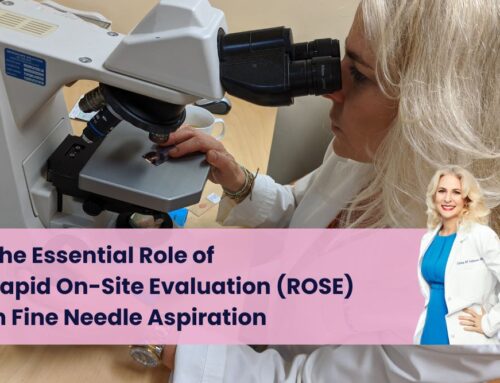
Table of Contents
- What is TIRADS?
- The Rise in Thyroid Nodules and Cancer
- Fine Needle Aspiration (FNA) and Its Role in Diagnosis
- TIRADS: A Standardized Approach to Thyroid Nodule Evaluation
- The Role of Nodule Size in Thyroid Cancer
- Active Surveillance and Small Thyroid Nodules
- Clinical Risk Factors Beyond Nodule Size
- Conclusion: Should Size Matter in Thyroid Nodule Biopsies?
- Frequently Asked Questions (FAQs)
- FNA Biopsy Resources
- Helpful Links
What is TIRADS?
TIRADS stands for Thyroid Imaging Reporting & Data System (TI-RADS), also known as the data system TI-RADS, developed by the American College of Radiology (ACR). It standardizes thyroid ultrasound reporting and aids in thyroid nodule management by assigning a risk of malignancy score based on sonographic features. The ACR TI-RADS system helps guide decisions about whether to perform a Fine Needle Aspiration Biopsy (FNA). This classification is especially helpful in evaluating benign nodules, TR4 thyroid nodules, and lesions found in the head and neck region that might otherwise be difficult to assess.

The Rise in Thyroid Nodules and Cancer
The incidence of thyroid nodules has increased due to improved thyroid imaging and ultrasound technology. As a result, more cases of thyroid cancer diagnosis are being made, including small and benign nodules that previously went undetected. While detection rates have risen, the risk of malignancy in most nodules remains low.
The ability to detect head and neck nodules and classify them accurately using data system TI-RADS ensures better decision-making and reduces unnecessary biopsies. Despite the increase in detection, mortality rates have stayed stable, showing the importance of accurate risk stratification rather than overtreatment.
Fine Needle Aspiration (FNA) and Its Role in Diagnosis
Fine Needle Aspiration (FNA biopsy) is a minimally invasive and highly accurate method used to distinguish between benign and malignant thyroid nodules. It remains an essential diagnostic tool in thyroid nodule management and thyroid cancer diagnosis. FNA is often performed under ultrasound guidance to target suspicious areas with echogenic foci or irregular margins.
It is crucial to be selective in recommending FNA, as over-biopsying low-risk nodules can lead to unnecessary surgery. For indeterminate nodules (Bethesda III & IV), which represent 5–20% of all thyroid nodules, only about 20% are malignant. Proper use of ACR TI-RADS scoring helps reduce false positives while ensuring that suspicious nodules like TR4 thyroid nodules receive prompt evaluation.

TIRADS: A Standardized Approach to Thyroid Nodule Evaluation
Before TIRADS, thyroid ultrasound interpretation varied between radiologists and practices. The primary goal of ACR TI-RADS is to standardize reporting and management recommendations, reducing variability in diagnosing thyroid nodules.
ACR TI-RADS scoring stratifies nodules based on malignancy risk and provides specific biopsy recommendations depending on size and ultrasound features such as composition, echogenicity, echogenic foci, and shape.
Although TIRADS improves consistency, some interobserver variability still exists due to differences in scanning techniques, operator experience, and subjective interpretation. This makes adherence to ACR TI-RADS guidelines essential for consistent and accurate diagnosis.
By categorizing nodules using sonographic features like composition, echogenicity, and margins, the data system TI-RADS enables better thyroid risk stratification and more precise recommendations for Fine Needle Aspiration Biopsy.
Even so, some variability in interpretation remains due to ultrasound scanning techniques and differences in experience among providers who manage head and neck nodules.

The Role of Nodule Size in Thyroid Cancer
While nodule size is a component of the TI-RADS classification, it is not a direct indicator of malignancy. Studies show that even small thyroid nodules can be malignant and may present significant oncologic risk.
For instance, low-risk follicular cancers smaller than 2 cm are less likely to metastasize, while larger nodules (>1 cm) are more associated with lymph node involvement and recurrence. However, size alone cannot predict aggressiveness; even TR4 or TR5 nodules under 1 cm can harbor malignant potential.
For example, benign nodules smaller than 2 cm may remain stable for years, while others with suspicious ultrasound features or echogenic foci could indicate higher risk. Larger nodules in the head and neck region may also cause symptoms like difficulty swallowing, warranting closer evaluation through Fine Needle Aspiration Biopsy.
Active Surveillance and Small Thyroid Nodules
Many endocrinologists and thyroid cancer specialists advocate for active surveillance in managing small thyroid cancers or TR3 and TR4 nodules. This approach involves monitoring with ultrasound imaging, delaying FNA biopsy until nodules meet size thresholds or show changes in echogenicity or echogenic foci.
In Japan, long-term studies have shown that active surveillance has no negative impact on survival, even when biopsy or surgery is delayed. This evidence supports a personalized thyroid management strategy, balancing early detection with reduced overtreatment.

Clinical Risk Factors Beyond Nodule Size
When evaluating a thyroid nodule, size should be considered alongside clinical risk factors such as:
- • Patient tolerance for active surveillance or surgery.
- • Mutational status or molecular profile, which may indicate aggressive cancer.
- • Quality of life factors, since larger nodules may affect swallowing, voice, or aesthetic concerns.
Small nodules especially those classified as TR4 thyroid nodules with echogenic foci should not be dismissed as low-risk. Each case should be evaluated holistically, combining ACR TI-RADS assessment, molecular testing, and clinical judgment.
Conclusion: Should Size Matter in Thyroid Nodule Biopsies?
Relying solely on nodule size to determine whether a Fine Needle Aspiration (FNA) should be performed is an outdated approach. The Thyroid Imaging Reporting and Data System (TI-RADS) provides a more precise framework for assessing sonographic features, including echogenic foci, margins, and shape.
By combining ACR TI-RADS scoring with molecular testing that identifies genetic mutations and tumor markers, clinicians can better understand each nodule’s malignancy potential. The fear of overtreatment should not result in underdiagnosis—especially for TR4 and TR5 thyroid nodules that may appear small but harbor abnormal cells.
FNA biopsy, when used alongside ultrasound imaging, CT scans, and molecular analysis, ensures precise diagnosis and prevents unnecessary surgeries. Personalized thyroid nodule management maximizes accuracy while protecting patient outcomes.





